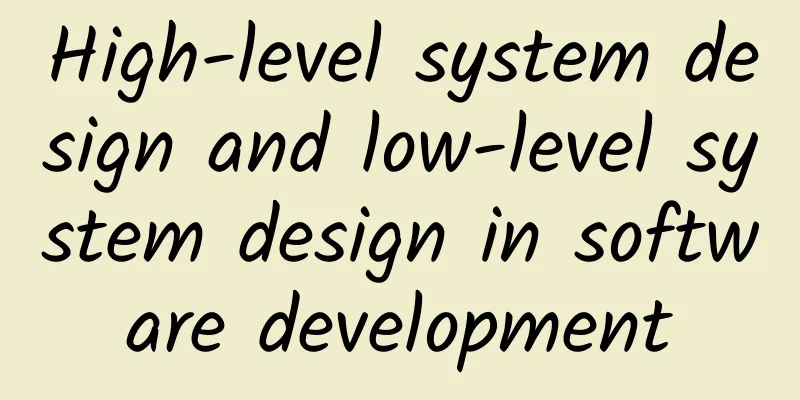High-level system design and low-level system design in software development

|
The software development cycle goes through many processes, High-Level System Design (HLSD) and Low-Level System Design (LLSD) are just two parts. Software Development Life Cycle (SDLC) goes through multiple phases like planning, requirement assessment, analysis, design, execution, documentation, testing, etc. Each phase is further divided into tasks with properly defined goals and outcomes. Analysis and design are the phases in which the actual architecture, working model, and execution procedures for building a software product are determined. Two key steps in these phases are high-level system design and low-level system design. What is Advanced System Design?High-Level Design (HLD) provides a comprehensive overview of the software development process, as well as a complete flowchart of system architecture, applications, database management, and systems and navigation. It is a blueprint that integrates the various steps and modules of developing software, their goals, variable components, results, architecture, and timelines. HLD transforms business plans into software products or services. Examples of HLDs in software development include system architecture documents, application development flow charts, etc. What is Low-Level System Design?Low-Level Design (LLD) deals with the planning, coding, and execution of the various components, modules, and steps in HLD at a single level. Each module in HLD has a unique LLD document that provides comprehensive details on how the module is coded, executed, quality tested, and integrated into the larger program. LLD provides an actionable plan by deconstructing HLD components into working solutions. Examples of LLD in software development include shopping cart integration, security testing, user interface design, etc. Difference between HLD and LLDHLD and LLD also have different functions and uses, such as high-level programming language and low-level programming language. Macro and Micro Architecture and DesignHLD is a macro design that provides a bird's eye view of the software development process. It includes diagrams, flow charts, navigation details, and other technical requirements that will form the crux of the development process. In addition to flow charts, diagrams, navigation information and technical requirements, LLD also provides comprehensive information about the step-by-step execution of each component of HLD. It deals with software development at a micro level. Each component of the HLD has a unique LLD document. Development timelineThe HLD precedes the LLD stage. Once the HLD is in place and approved for execution, work on the individual LLDs can begin. HLD begins after the planning and requirements phases are addressed and has no other dependencies. On the other hand, LLD requires execution in a specific order. Some modules must wait to execute until other modules are completed. LLD belongs to the design phase of SDLC, while HLD belongs to the analysis phase of SDLC. PurposeThe purpose of the HLD is to list the functional aspects of the various modules and the end results. The purpose of the LLD is to detail the logic and execution of each module in the HLD. StakeholdersThe Solution Architect is responsible for creating the HLD document. It can have internal and external stakeholders such as the review team, design team, customers, and managers who are responsible for understanding the software metrics. LLD is handled by software developers, web administrators, security engineers, etc. within a company or vendor team. LLD is usually limited to internal stakeholders. Target AudienceThe target audience for HLD documents are managers, customers, and software development teams. Software engineers, coders, testers, and developers working on the project are the target audience for LLD documents. Expected ResultsThe result of HLD is a software product or service that is ready for delivery to the end user. The result of LLD is the completion of a single module of HLD, such as the coding or testing phase. Understanding Software Design DocumentsIn addition to technical requirements and other implementation details, software design documents outline the structural, functional, and logical aspects of developing a software product or service. Whether the design deals with the macro level or the micro level of execution, programmers and other stakeholders should know and understand the scope and individual steps of the software development process. |
<<: iOS 16 beta 7 released, iOS 16 official version is coming
Recommend
The era of paid content: both a hot topic and a hidden crisis
Last year, a wave of paid content entrepreneurshi...
How to name a brand? There are several common methods
The name should tell potential customers what the...
Essential points for private domain operations on WeChat for enterprises, save them now!
Nearly two months have passed since the launch of...
With a low budget and high bid, how can you play Baidu bidding promotion?
Recently, I have sorted out several of the most f...
Bidding tutorial: How to formulate a mobile bidding promotion strategy?
In recent years, due to the rapid rise of mobile ...
Quickly develop your own WeChat applet in two days?
Why should you learn mini program development? Wh...
How to write the copy for May 1st Labor Day?
It’s not Labor Day yet. The chat mode of " w...
Sneezing in the light is caused by brain dysfunction
I wonder if you have such a friend around you. Or...
2021 Douyin live broadcast new trend: Enterprise self-broadcasting anti-scam guide
Douyin’s e-commerce trend has made Luo Yonghao, B...
Yongge's Xiaohongshu quick money-making project
Yongge's Xiaohongshu quick money-making proje...
OPPO N3 unboxing experience: exquisite rotating lens from inside to outside
Since N1, the rotating lens design has become OPP...
How much does it cost to develop a watch mini program on the market in Hexian County?
In order to better penetrate into various industr...
16 Lectures on Cosmology by Professor Zhao Zheng from the Department of Physics, Beijing Normal University
Introduction to Professor Zhao Zheng's 16 Lec...
Data | Online advertising revenue exceeded 67 billion in Q2 2016, data drives advertising value increase!
Overview of Internet Advertising Development in Q2...
Why is it so difficult for contemporary women to overcome "exquisite shame"?
High heels shame, diamond ring shame, makeup sham...









